Abstract
Since 2020, Europe has introduced strategies and key policies to promote common efforts on a roadmap toward energy efficiency and decarbonization. From ‘low’ to ‘passive’ and from ‘zero’ to ‘positive’, the concepts have fascinated the scientific community around the globe and promise the deployment of planning responses to the challenges of decarbonization faced by the European and local agendas. This works provides an overview of a comprehensive understanding of emerging concepts with a focus beyond the boundaries of an individual building. The booklet of 51 European projects, firstly introduced in Joint Programming Initiative documents, unveiled the prioritization of energy efficiency and the path for the enhancement of environmentally friendly communities. In this sense, this work presents an overview of the Net-Zero Energy Districts, and beyond, namely through the discussion of different aspects and dimensions. Based on published scientific literature, this work collects, organizes and discusses approaches of European cases, concluding with the knowledge base to support further developments and reinforce an established pathway for future implementations.
1. Introduction
The United Nations’ latest IPCC report (2021) argues that the scenario faced is that 11 years remain before triggering an irreversible climate disaster on Earth [1]. Increasing evidence reveals the gravity of climate mitigation at macro and micro levels [2], making a roadmap toward a clean energy transition a priority, and perhaps one of the greatest challenges of humankind. In his book, ‘The 3rd Industrial Revolution’, Rifkin underlines that “our houses must become a power plant using geothermic, solar, wind, even rubbish will be a major source of energy” [3]. Saheb et al. accentuate highly energy-efficient buildings as the cornerstones of decarbonization with meaningful impact [2]. Nevertheless, reducing global emissions calls for long-term transformations in production processes, daily mobility and adapted behaviors and strengthens the need for synergies among actors and citizens.
Nevertheless, achieving decarbonization in 30 years is a huge challenge requiring systemic and radical urban transformations. Climate-neutral cities have a mission to address climate adaptation and attenuation through resilient strategies, risk and vulnerability assessments and concrete actions. As innovation hubs, European cities are the global forerunners able to tackle this challenge and accelerate this transition, along with the mission for carbon neutrality, to boost a twofold objective [4]:
- Setting the GHG reduction target by 2030 at 100%;
- Leading a systemic and comprehensive adaptation through the development of bottom-up and horizontal governance mechanisms.
In this pathway, there has been a rapid increase in initiatives and interest to make pledges to this transition by mid-century (Figure 1) [5]:
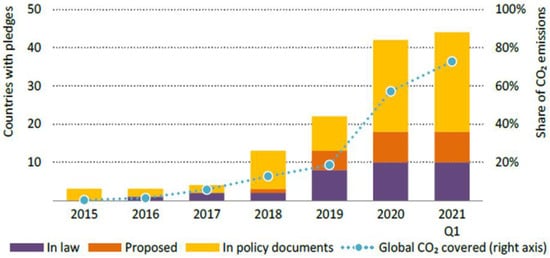
Figure 1.
Total final consumption and demand by mitigation measures in zero-energy scales.
In reality, the dawn of this engagement finds its roots at the early beginning of the 1950s with the ECSC and the EURATOM Treaty (1957), intended to bring together knowledge- and infrastructure-sharing and promote the peaceful use of nuclear energy [6]. In this arena, several other relevant policies provided a legislative framework to enable MS to reach its targets. In this sense, important milestones in the path towards tackling climate change appeared in 2007—the “2020 Climate and Energy Package” [7]—and, later, in October 2014 with the definition of the “2030 Climate and Energy Framework” [8]. In 2018, in line with the EU’s commitment to global climate action under the Paris Agreement [9], the European Commission set out on the “2050 long-term strategy” for a climate-neutral EU, looking at all the key sectors and exploring pathways for this transition [10].
These main roadmaps and strategies have crystallized during the last decades in a set of regulatory packages that pave the way to reaching these ambitions. It is, however, commonly agreed that is necessary to scale up to district-level approaches, since they are one of the potentially most effective approaches to speed up the decarbonization process. This point is mentioned in different recommendations, such as CR-EU 2019/786 of 8 May 2019 on building renovation [11] or the update of the EPBD in 2018 which states that the Commission “shall review this Directive by 1 January 2026 at the latest” and “as part of that review, (…) examine in what manner Member States could apply integrated district or neighborhood approaches in Union building and energy efficiency policy (…) using overall renovation schemes applying to several buildings in a spatial context instead of a single building” [12]. In addition, the “Renovation Wave Strategy”, one of the energy-related actions of the European Green Deal and published by the European Commission in 2020 to double the annual energy renovation rate of buildings, remarked upon the necessity of developing district and community approaches and integrating renewable solutions for creating zero-energy districts, since “aggregating projects at this level may lead to zero-energy or even positive energy districts” (Table 1) [13].

Table 1.
EU 1st Climate and energy package objectives and progress.
1.1. Research Scope
In this paper, the authors contextualize the accelerating efforts to seek the operationalization of high-energy-performance districts and present a systematic analysis of selected projects of European portfolios. So far, the perception of PEDs has been predominately researched from a technological perspective. Nevertheless, in-depth comprehension of the concept requires a focus on the multifaceted analysis of organizational, legal, financial, urban and institutional issues as well as effective instruments and structures. In this work, the spectrum definitions for PEDs through the different levels and dimensions is leveraged over a portfolio of 51 projects. The literature gap is unveiled and the extant challenges are filtered to achieve significant contribution toward synthesizing and enriching the concepts along with practical examples and accomplishments.
1.2. Structure
After a brief historical analysis of the concept’s origin, a comprehensive understanding of the ‘zero’ to the ‘positive’ energy ambition is introduced. A systematic review is followed underlining the importance of boundaries and the interest of the urban scale to enable the penetration of 2050 decarbonization strategies, emphasizing PEDs as pivotal means of contributing to a transition away from fossil fuel dependence and toward urban resilience. The remainder of the manuscript is organized as follows: Section 3 contributes to the embedded challenges and constraints of the pathway for the ‘zero’ to ‘positive’ roadmap. Section 4 proposes a booklet of 51 European projects as paramount to energy efficiency initiatives, while Section 5 synthesizes the main findings and challenges for further development. The work plan and the organization of the study are presented in Figure 2.

Figure 2.
Work plan and organization.
2. Understanding the Concepts—A State-of-the-Art Analysis
Starting with a comprehensive analysis of the concepts is an important lever to identify the lessons learnt and the evolution of the diverse applications of energy autonomy. The existing literature and previous works propose an umbrella of definitions, sometimes contradictory; a prism of them is provided in this section.
2.1. Brief Historical Background
The origin of the ‘zero-energy’ concept is traced back to 1976, when Esbensen and Korsgaard studied the solar heating of an experimental residential building (Figure 3) [14] and dubbed it the ‘Zero Energy House’ [15].
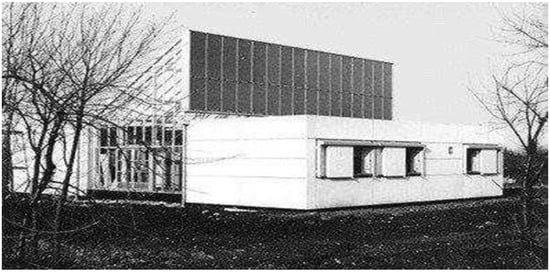
Figure 3.
The first experimental ‘zero-energy’ house (1976).
At the pathway towards building-scale zero-energy strategies, other prototypes are considered:
- the ‘Impact 2000 house’ built by the Boston Edition to demonstrate to the public state-of-the-art energy technologies and conservation techniques (including photovoltaic arrays, passive heating systems, air-to-air heat exchanger, etc.) [16];
- the prototype of ‘Carlisle house’, developed in 1980 for the US Department of Energy as the first building with an integrated PV system, included an exemplar residential roof and was known for its passive solar heating and cooling systems. Carlisle is the first residential building in US powered by a utility-interactive PV system with no fossil fuel needs and which exports surplus power [17];
- the pioneering realizations proposed by Rolf Disch based on a solar estate of ‘plus-energy houses’ in Freiburg (Germany) built towards a holistic testing ground for ecological constructions, with plus-energy dwellings (50 terraced houses) being one of the major components [18];
- the manifesto of Powerhouse at Brattorkaia (Norway), the world’s northernmost energy-positive building, setting new construction standards and producing more than twice as much electricity as it consumes daily with RES supplied to itself, neighboring buildings, etc., through a local microgrid. The building leverages a series of technologies and noticeably reduces the energy used for its operation [19].
Nevertheless, it was only in the early 2000s when the concept gained traction in both research and policymaking due to its demonstrated success [8].
2.2. Spectrum of Definitions
Whereas the understanding of the zero-energy idea sounds simple, a range of terminologies exists currently in the literature. The NZEB concept has been primarily linked to an evolution of bioclimatic architecture and passive housing [6] and has introduced an integrated and comprehensive approach to energy efficiency and on-site (or nearby) production [20]. Broadly, the idea was explained as an ‘autonomous’ building targeted to operate with the off-grid generation of all energy required, without referring to connections to the ‘grid’ [21].
A thorough analysis, proposed by Brozovsky et al., searching Scopus and Web of Science (updated in 2021) with the filters of ‘article title’, ‘abstract’ and ‘keywords’ unveils a plethora of relevant studies on the building level (more than 2000 documents) [22]. D’Agostino and Mazzarella launched an in-depth and similar analytical process provided in Table 2 [23].

Table 2.
Overview of main terms in the literature around the zero-energy concept in buildings.
2.3. Expansion of the Concept on Urban Scale
Even though the debate about the definitions of ‘district’ (and/or ‘neighborhood’) has not yet come to a consensus, the terms are accepted by their original significance and relation to a ‘community’ [30]. The transition beyond single buildings to include larger scopes increases the complexity of the different approaches and is found in several theories [31]. Figure 4 is an example of the rising scientific interest in this challenge [32].
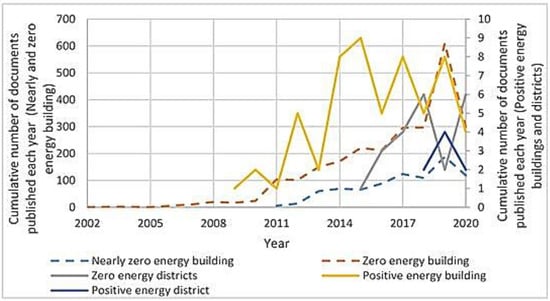
Figure 4.
Rising interest of the scientific community in the zero-energy concept on an urban scale.
Especially concerning the spatial dimension, there are terms, usually ambiguous, about when to call a ‘cluster of buildings’ or a ‘neighborhood’ or a ‘district’, a ‘block’, a ‘community’, etc., but also a vast terminology to express zero-energy patterns. Most used are: ‘nearly Zero Energy Neighborhood’ (NZEN), ‘Positive Energy Block’ (PEB), ‘Energy Positive Neighborhood’ (EPN), ‘Low Carbon District Heating’ (LCDH), ‘Zero Energy District’ (ZED), ‘Zero Carbon District/Neighborhood’ and ‘Net Zero Exergy District’ among others. To address this problem, Brozovksy et al. argue that the proportion of the literature using the term ‘neighborhood’ to express the boundaries outweigh those using ‘district’ or even ‘block’, while most of the more frequently used terminology is related to the energy or emission balance over a specific accounting period (usually within a year), and use of the term ‘low carbon’ is fairly vague [22].
A first approach towards the definition of zero-energy districts is found in the works of Carlisle et al. [33], stating that:
[….]‘a net-zero energy community has greatly reduced energy requirements through energy efficiency gains of vehicles; thermal and/or electrical energy within the community is met by RES’.
In 2014, Marique et al. adapted this definition, considering the energy consumed in a district as the ‘sum of the demand of each dwelling and the mobility of its users’ [34]. Kennedy and Sgouridis [35] questioned the challenge, whereas Todorovic searched for the role of simulation tools in zero-energy urban planning [36].
Among the related topics, the research concludes:
- The majority of the publications focus on energy systems, energy sharing and GHG emissions (e.g., EU, 2010) in buildings, on-site supplies, etc. A large part addresses multi-energy systems and resource management (e.g., [13,14,37]), while an assessment of energy production is also commonly found (e.g., [38,39,40]) or even of the inclusion of storage systems, with some articles focusing on thermal (e.g., [41]) or on electrical storage.
- From another angle, the research project ZenN [42] proposes a definition whereby the global energy demand of a residential cluster meets the local energy production by resources on-site in renovating processes, considering the neighborhood as a sum of buildings. In this sense and by analogy, the Nearly Zero-Energy District is a part of a city with ‘nearly zero or very low amount of energy covered to a very significant extent by energy from renewable sources produced on-site or nearby’. Frequently, Mixed-Integer Linear Programming was used, as well as Model Predictive Control [43] or a non-linear model to simulate the distribution and connection to the public grid. Boccalatte et al. discussed the optimal arrangement of building-integrated PV to reach zero-energy layouts [44].
- Stakeholder engagement: utility of a ‘smart energy community’, ‘innovative public procurement’ [45] or ‘citizen empowerment’ [46], ‘Public–Private’ synergies [47] or even the visualization of key factors for improved participatory processes and governance mechanisms [48] are discussed.
- Urban morphology: historically, the correlations between density, energy consumption and mobility were thoroughly investigated; for instance, in the study of Newman and Kenworthy [49]. Amaral et al. reviewed urban parameters influencing the energy balance in NZEDs [50]. Guarino et al. studied solar energy optimization in the Mediterranean in line with a parametric analysis of geometrical and other relevant factors [51]. Wang et al. suggested an indicator system design exploring the relationship between the land-use data [52] and household CO2 emissions in Beijing [53], while others (e.g., [54]) developed cartographical visualization to assess the influence of urban form and building typology on the energy performance and carbon emissions (cases in Macau and Chi). Other authors analyze assessment methods for energy use in urban forms, such as the creation of energy modeling systems of the embodied energy.
Refs. [55,56,57].
- Social aspects: Tironi performed research on a public experiment in the form of a laboratory in Santiago de Chile, where a district was temporarily transformed through a design process to monitor the air pollution and the microclimate [58]. Woods and Berker discussed the limitations and potential associated with the concept of ‘living labs’ in zero-energy patterns in a Norwegian case [59].
Lindholm et al. [60] provided a synthesis of zero-energy terms that addressed building- or urban-level applications and focus on energy efficiency, renewable resources, storage and trading (Table 3). As a comparative analysis, the Table below reveals the complexity within the concepts’ understanding of the relevant approaches; nonetheless, despite the differing angles of analysis, all the concepts agree on the balance and increase of RES share.

Table 3.
Synthesis of zero-energy definitions (adapted by [60]).
To this end, Table 4 summarizes a set of methodological approaches and the advances in the literature review complementary to Table 3 and the previous analysis. Summarizing the existing studies, a lack of cross-sectoral and holistic views on the topic is observed, revealing the complexity and challenges of the topic in a multidimensional context (urban, societal, legislative, etc.).

Table 4.
Methods and tools found in the literature to support the study of the district scale (adapted from [50]).
Synthesizing the main findings of the literature, a bibliometric analysis to figure out the correlations in line with the Scopus database is displayed using the keywords of ‘positive’ and ‘energy’ for the published works from 2000 onwards. In particular, for the building level, more than 3700 documents are detected (Figure 5) compared to 650 for the district scale (Figure 6), endorsing the research gap and the complexity. Nonetheless, the aggregation per country is similar; China, India and the United States aggregate more than 1000 citations, whereas in Europe, Italy, the UK, Finland and Sweden have a notable number of citations as well.
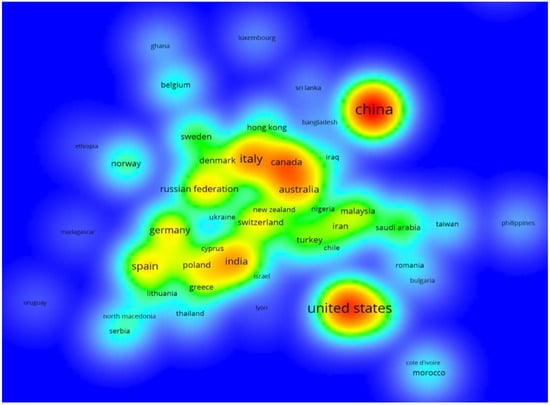
Figure 5.
Correlation of ‘positive’, ‘energy’, ‘building’ (own elaboration from Scopus database).
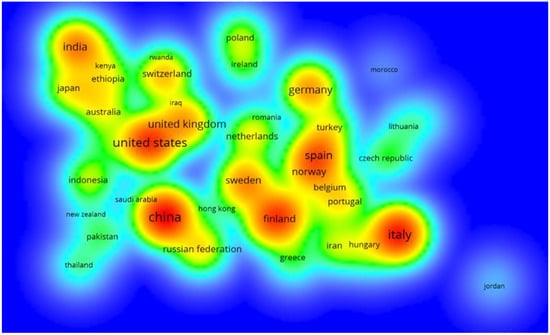
Figure 6.
Correlation of ‘positive’, ‘energy’, ‘districts’ (own elaboration by Scopus database).
3. From ‘Zero’ to ‘Positive’: A Rapid Evolution of the Concepts
After the overview of the main concepts presented in the previous section, an introduction on PEDs’ milestones is provided along with the key pillars to be considered for their implementation.
3.1. TWG 3.2: An Introductive Dimension towards PEDs
To take advantage of the benefits of zero-energy applications, the EU launched the strategy of ‘Plan Action 3.2: Smart Cities and Communities’ [88], being recognized as one of the major tools to deliver the ‘Energy Union Strategy’ and support the replication of 100 ‘Positive Energy Districts’ by 2025 [89]. In this challenging concept, the PEDs are defined as: ‘Energy-efficient and flexible urban areas or groups of connected buildings, which produce (net) zero GHG emissions and actively manage an annual local or regional surplus production of RES’ [90].
The TWG 3.2 developed an integrative approach for positive-energy planning including technological, spatial, regulatory, financial, legal, environmental, social and economic perspectives, summarized as:
- a pathway towards PED development in Europe and worldwide;
- the generation of a commitment to innovative research and implementation actions for process monitoring;
- a continuous PED management ensuring coordination of related activities.
The main functions of PEDs, as presented in the 3.2 Program (Figure 7), with the ambition of reaching the COP21 targets are [9]:

Figure 7.
Pathways to Positive-Energy Districts in Europe (SET-Plan ACTION n°3.2 Implementation Plan).
- Energy efficiency: achievement of an optimal reduction of energy consumption within the PED balancing the requirements of the different sectors;
- Energy flexibility functions: resilience and balance of the urban energy systems coupling the storage potential towards their autonomy;
- Energy production function (locally and regionally): optimal reduction of GHG emissions and economic viability.
Regulatory stimuli and public funding for research projects led to a considerable amount of dissemination as documented in the IEA report (Annex 83 on PED) [91]. Since 2018, the concept has been introduced to the debates acknowledging that the urban scale has a major role in this process, making it a strategic key for carbon neutrality by 2050 [92]. Hinterberger et al. [93], in their ‘White Paper on the Reference Framework for Positive Energy Districts and Neighborhoods’, defined the PED as a ‘group of connected buildings’; however, in Annex 83 the description is provided without any clear focus on the GHG emissions, merely: ‘A PED is an area within the city boundaries, capable of generating more energy than is used, flexible and adequate to respond to the energy market variations. Rather than simply achieving an annual net energy surplus, it supports in parallel a minimization of impacts on the connected centralized networks by offering alternative options for increasing onsite load-matching and self-use of energy and technologies. Nonetheless, reaching the PED ambitions requires prioritizing the energy efficiency, cascading the local energy flows and using the low-carbon flexibility to match the (annual) demand with the maximization of the local production, while in parallel minimizing the burdens and optimizing their usefulness at large’.
Figure 8 represents a briefing on the concept and the interchangeable components with possible connections of the district’s components to local energy production are also found in the literature [94]:
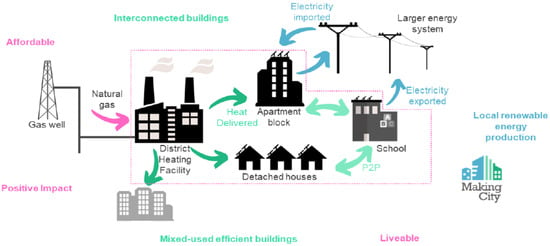
Figure 8.
PED components and interchangeable connections.
Yet, there is no unified and commonly acknowledged PED definition; meanwhile, an adequate policy framework is required at regional and national levels to concretize the boundaries, specify the objectives and reinforce the commitments and synergies. For Europe, the ambition is noticeable [93]:
100 Positive Energy Districts in Europe are expected to be in concrete planning, construction, or operation, synergistically connected to the energy system in Europe, by 2025.
From the above definitions, it is acknowledged that the PEDs’ implementation requires in-depth comprehension of contextual conditions, policies and strategies for user adaptation [95]. Existing PED definitions address the fact that a PED is an added value to the users and enables high-quality living standards.
3.2. Issues and Related Concepts
As an emerging concept, PED is developed along with several criteria, constraints and levels of interpretation [64]:
- Primary energy indicators: conversion efficiency of the energy from primary sources to the delivered carriers to the end users to convert the building demand and later to evaluate its performance [20].
- PED (and PEB) categorization: a variety of different types and categories of PED/PEBs according to their (physical) boundaries.
- EV integration: one of the main objectives of this concept is to minimize the negative effects on the grid and reduce the need for energy transfer. Zhou et al. [96] analyze energy integration and its interaction between buildings and vehicles regarding different energy forms, advanced conversions, storage systems, etc.
- Energy integration as the driver for circular economy renewables and further efficiency: achieving PEDs requires an integrated approach toward energy systems planning, development and operations across all energy infrastructure. Buildings and urban energy systems work together to optimize temperature levels, time of use and storage opportunities to minimize total life cycle cost while also recording input from usage patterns, weather predictions and future utility costs.
- Citizen engagement, governance mechanisms and participation: incorporation of fact-based and proactive communication, transparent and inclusive frameworks for public participation in decision-making processes and efficient governance mechanisms.
- RES integration at regional/local levels: development of demonstration technologies, systems and solutions to match temperatures with locally available low-carbon sources and other techniques to enable buildings’ operation with low supplies and on-site production in a cost-effective and sustainable process.
4. A Booklet of Good Practices
The Strategic Energy Technology Plan of 2008 and the Joint Programming Initiative defined an outlook of PED projects (grouped into three categories: Implemented/In Operation (2), Projects in Implementation Stage (18) and Projects in Planning Stage (8)).
The first Positive Energy Block in operation in Europe was the ‘Hikari’ project (‘light’ in Japanese) and was completed in 2015, described by Roccamena et al. [92]. Located on the most emblematic site of the new Confluence District, it brings together commercial, residential and leisure functions in the southwest of the center of the French city of Lyon (Figure 9). Key development targets of this particular project include high environmental patterns, harnessing technology, walkability and QoL indices as well as the social, cultural and economic vibrancy designed to bioclimatic standards.
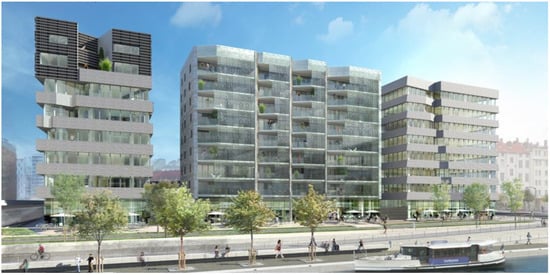
Figure 9.
View of Hikari, first PED project in France (©Renaud Araud).
4.1. Results
For this study, a portfolio of 51 European projects with zero or positive targets is discussed, analyzed and compared (Figure 10). A concentration of PED projects appears in Norway, Italy, Finland and the Netherlands.
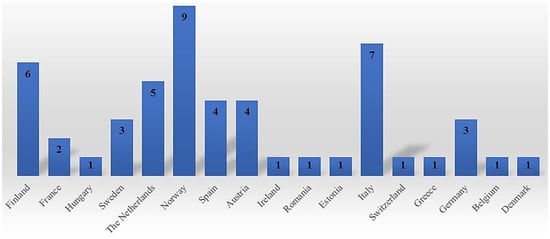
Figure 10.
Number of analyzed (European) projects within the zero- (or positive)-energy context per country.
On the other side, Table 5 unveils in more detail the overview of these projects in each country; the majority of them include at conception comprehensive urban strategies against climate change and toward mitigation beyond energy efficiency. Representative examples are provided in Table 6.

Table 5.
List of representatives in the literature with PED ambitions (adapted from [97]).

Table 6.
List of representative cases with energy efficiency objectives (but not PED concepts) (adapted from [97]).
4.2. Analysis of Realized and Under-Construction Projects in a Zero- or Positive-Energy Context in Europe
In line with the criterion of the implementation phase of the analyzed projects, the conducted analysis study reveals the level of complexity and the multifaceted dimensions of their context, including the societal and economic barriers complementing the technical ones. Figure 11 portrays the cartographical distribution of the analyzed projects in the European continent unveiling the pioneering role of the Netherlands and Norway (five projects, respectively, with PED concepts under construction) in the process, while Sweden and Spain seem to have obtained already the first lessons learnt with realized projects in their territories.

Figure 11.
Number of (studied) European projects within a zero- (or positive)-energy context under construction (left) and realized (right).
Complementary to the previous statements, the analysis provides the prioritization of the projects’ targets per country. As expected, the first concern for a plethora of countries is energy efficiency and the minimization of the environmental impacts due to climate change in order to reply to the 2030 and 2050 engagements (Figure 12). To respond to these objectives, countries prioritized the mutualization of different technologies and available on-site resources to maximize local production. The analysis emphasizes the prioritization of solar potential (solar panels and PVs) and heat pumps or geothermal exploitation. The organization of storage has rising interest for many cities as well towards autonomy. Notably, of lessening priority are the projects in economic or social contexts.
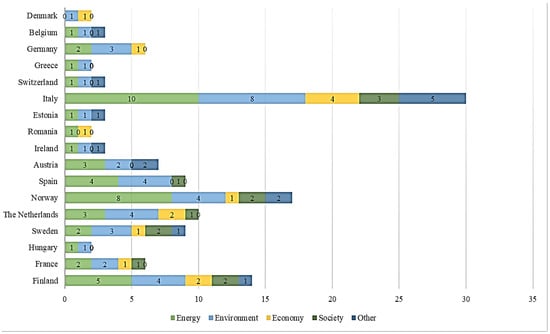
Figure 12.
Number of projects per objective(s) in European studied cases.
5. Conclusions and Future Challenges
The deployment of the energy efficiency roadmap provides a framework for intensified efforts by all European Member States from 2020 onwards to develop strategies to deal with the inherent challenges of energy consumption associated with GHG emissions. Significant work has been explored around the globe on possible variations of the zero-energy idea at the building level on models for design calculations and outreach of case studies. Even though there is a lack of far-reaching definitions to characterize the concept, namely on an urban scale, it consists of a promising design for the mitigation of climate change for the coming decades toward a clean energy transition and an inclusive economy. Under the Europe 2020 strategy, the flagship initiatives supported resource-efficient and low-carbon communities, while the pathway is reinforced toward the 2030 and 2050 horizons for higher standards of living and minimized impacts with robust and resilient action plans.
This works provides an overview of comprehensive understandings of the concepts’ evolution from ‘zero’ to ‘positive’ energy transitions, underlying the strong engagement on an urban scale and the need for intensive efforts to achieve climate change mitigation. To move beyond the boundaries of an individual building—applying the concepts of energy efficiency from an urban planning perspective—increases the complexities and the respective level of implementation difficulty; however, it also fosters an overall design to overcome the existing barriers for financial, societal or other reasons. In reply to this challenge, the Program on PED (Action 3.2) supports the replication of 100 PEDs across Europe by 2025, reaching the goal set by the COP21 agenda.
The booklet of 51 European projects, under construction or realized, unveiled and confirmed the prioritization of the key policies of energy efficiency and the path toward the enhancement of environmentally friendly communities. The analysis also highlighted not only the importance of energy mutualization for the diverse technologies and RES exploitation, but also the compelling constraints of social acceptance and financial limitations.
An enhancement of the studies to unify the concepts and assess the feasibility of their implementation is a primary concern. When moving to the urban scale to analyze the district as a whole, additional design factors have a significant role in performance evaluation, and the literature has evidenced a lack of appropriate methodologies and tools that account for all these parameters, either for researchers or practitioners and stakeholders.
Hence, in this sense, this work presented a literature review on the NZED—and beyond—concepts, namely, through the discussion of different aspects to take into account when designing or studying. Based on published scientific literature, this work collected, organized and discussed approaches of European cases, while concluding with contributing to establishing a knowledge base to support further developments and reinforce the established pathway for future implementations.
Funding
This research received no external funding.
Institutional Review Board Statement
Not applicable.
Informed Consent Statement
Not applicable.
Data Availability Statement
Not applicable.
Acknowledgments
The author would like to thank Prof Bouillard for his valuable guidance and help.
Conflicts of Interest
The author declares no conflict of interest.
Nomenclature
| Abbreviation | Definition |
| BEMS | Building Energy Management Systems |
| CE4E | Clean Energy for all Europeans |
| CIM | City Information Modeling |
| ECSC | European Coal and Steel Community |
| EURATOM | European Atomic Energy Community |
| EPBD | European Performance Building Directive |
| EPN | Energy-Positive Neighborhood |
| EVs | Electric Vehicles |
| EU | European Union |
| GIS | Geographical Information Modeling |
| GHG | Greenhouse Gas (emissions) |
| HEMS | Home Energy Management Systems |
| IEA | International Energy Agency |
| IPCC | Intergovernmental Panel on Climate Change |
| JPI | Joint Programming Initiative |
| LCDH | Low-Carbon District Heating |
| NREL | National Renewable Energy Laboratory |
| nZEB | nearly Zero-Energy Building |
| NZEB | Net-Zero-Energy Building |
| NZEC | Net Zero-Energy Cost |
| NZED | Net-Zero-Energy District(s) |
| NZEN | Net-Zero-Energy Neighborhood |
| PEB | Positive-Energy Block |
| PED | Positive-Energy District(s) |
| PROMETHEE | Preference Ranking Organization Method for Enrichment Evaluations |
| PV | Photovoltaic |
| QoL | Quality of Life |
| RES | Renewable Energy Sources |
| SET | Strategic Energy Technology |
| TRNSYS | Transient Systems Simulation Program |
| TWG | Temporary Working Group |
| ZEB | Zero-Energy Building |
| ZenN | Zero-Energy Neighborhood(s) |
References
- Intergovernmental Panel on Climate Change (IPCC). IPCC Special Report on Carbon Dioxide Capture and Storage; Cambridge University Press: Cambridge, UK, 2005. [Google Scholar]
- Saheb, Y.; Shnapp, S.; Paci, D. From Nearly-Zero Energy Buildings to Net-Zero Energy Districts; Publications Office of the European Union: Luxembourg, 2019. [Google Scholar]
- Rifkin, J. The Third Industrial Revolution: How Laterla Power is Transforming Enery, the Economy and the World, 1st ed.; Palgrave Macmillan: London, UK, 2013. [Google Scholar]
- European Commission. Proposed Mission: 100 Climate-Neutral Cities by 2030-by and for the Citizens; Report of the Mission Board for Climate-Neutral and Smart Cities; European Commission: Brussels, Belgium, 2020. [Google Scholar]
- International Energy Agency. Net Zero by 2050: A Roadmap for the Global Energy Sector. 2021. Available online: https://iea.blob.core.windows.net/assets/4719e321-6d3d-41a2-bd6b-461ad2f850a8/NetZeroby2050-ARoadmapfortheGlobalEnergySector.pdf (accessed on 15 October 2022).
- European Commission. Treaty Establishing the European Atomic Energy Community (EURATOM). 1957. Available online: https://www.cvce.eu/en/obj/treaty_establishing_the_european_atomic_energy_community_rome_25_march_1957-en-a3390764-3e75-421b-9c85-f52de5a14c2f.html (accessed on 15 October 2022).
- European Commission. 2020 Climate and Energy Package. 2020. Available online: https://ec.europa.eu/clima/eu-action/climate-strategies-targets/2020-climate-energy-package_en (accessed on 3 February 2022).
- European Commission. 2030 Climate and Energy Framework. 2020. Available online: https://ec.europa.eu/clima/policies/strategies/2030_en (accessed on 3 September 2021).
- European Commission. Paris Agreement. Paris. 2015. Available online: https://eur-lex.europa.eu/content/paris-agreement/paris-agreement.html (accessed on 2 November 2022).
- European Commission. 2050 Long-Term Strategy. 2020. Available online: https://ec.europa.eu/clima/eu-action/climate-strategies-targets/2050-long-term-strategy_en (accessed on 3 May 2022).
- European Commission. Commission Recommendation (EU) 2019/786 of 8 May 2019 on Building Renovation. 2019. Available online: https://op.europa.eu/en/publication-detail/-/publication/4a4ce303-77a6-11e9-9f05-01aa75ed71a1/language-en (accessed on 3 May 2022).
- European Commission. Directive (EU) 2018/844 of the European Parliament and of the Council of 30 May 2018 Amending Directive 2010/31/EU on the Energy Performance of Buildings and Directive 2012/27/EU on Energy Efficiency. 2018. Available online: https://eur-lex.europa.eu/legal-content/EN/TXT/?uri=uriserv%3AOJ.L_.2018.156.01.0075.01.ENG (accessed on 3 May 2022).
- European Commission. Communication from the Commission to the European Parliament, the Council, the European Economic and Social Committee and the Committee of the Region; European Commission: Brussels, Belgium, 2020. [Google Scholar]
- Esbensen, T.V.; Korsgaard, V. Dimensioning of the solar heating system in the zero energy house in Denmark. Sol. Energy 1977, 19, 195–199. [Google Scholar] [CrossRef]
- Andoura, S.; Vinois, J.-A.; Delors, J. From the European Energy Community to the Energy Union: A Policy Proposal for the Short and Long Term. 2020. Available online: https://institutdelors.eu/wp-content/uploads/2020/08/energyunion-andouravinois-jdi-jan15.pdf (accessed on 3 May 2022).
- Jurgen, R.K. Impact 2000: A place in the sun: Sponsored by Boston Edison as an energy-conservation experiment, this home in the suburbs was seen during its construction by public-television viewers across the United States. IEEE Spectr. 1985, 5, 64–68. [Google Scholar] [CrossRef]
- Solar Design Associates. Carlislie House. 1980. Available online: http://solardesign.com/carlisle-house/ (accessed on 19 November 2022).
- Heinze, M.; Voss, K. Goal: Zero Energy Building, Exemplary experience based on the solar estate. Solarsiedlung Freiburg am Schlierberg, Germany. J. Green Build. 2009, 4, 93–100. [Google Scholar] [CrossRef]
- Entra. Powerhouse Brattorkaia—The World’s Northernmost Energy-Positive Building. 2019. Available online: https://snohetta.com/projects/456-powerhouse-brattorkaia-the-worlds-northernmost-energy-positive-building (accessed on 19 November 2022).
- European Commission. Concentrated Action: Energy Performance of Buildings (EPBD). 2010. Available online: http://www.epbd-ca.eu/ (accessed on 5 January 2015).
- Directorate-General for Research and Innovation. A Climate Resilient Europe: Prepare Europe for Climate Disruptions and Accelerate the Transformation to a Climate Resilient and Just Europe by 2030: Report of the Mission Board for Adaption to Climate Change, Including Societal Transformation; European Commission: Brussels, Belgium, 2020. [Google Scholar]
- Brozovsky, J.; Gustavsen, A.; Gaitani, N. Zero emission neighbourhoods and positive energy districts—A state-of-the-art review. Sustain. Cities Soc. 2021, 72, 103013. [Google Scholar] [CrossRef]
- D’Agostino, D.; Mazzarella, L. What is a nearly zero energy building? Overview, implementation and comparison of definitions. J. Build. Eng. 2018, 21, 200–212. [Google Scholar] [CrossRef]
- Panagiotidou, M.; Fuller, R.J. Progress in ZEBs: A review of definitions, policies and construction activity. Energy Policy 2013, 62, 196–206. [Google Scholar] [CrossRef]
- Lund, H.; Arler, F.; Ostergaard, P.A.; Hvelplund, F.; Connolly, D.; Van Mathiesen, B.; Karnoe, P. Simulation versus optimisation: Theoretical positions in energy system modelling. Energies 2017, 10, 840. [Google Scholar] [CrossRef]
- Torcellini, S.; Pless, M.; Deru, D.; Crawley, P. Zero Energy Buildings: A Critical Look at the Definition. In ACEEE Summer Study Pacific Grove; National Renewable Energy Lab.(NREL): Golden, CO, USA, 2006. [Google Scholar]
- Sartori, I.; Lollini, R. Nearly-zero, Net zero and Plus Energy Buildings-How definitions and regulations affect the solutions. REHVA J. 2012, 12, 23–27. [Google Scholar]
- Laustsen, J. Energy Efficiency Requirements in Building Codes, Energy Efficiency Policies for New Buildings; International Energy Agency (IEA): Paris, France, 2008. [Google Scholar]
- Zacà, I.; D’Agostino, D.; Congedo, P.M.; Baglivo, C. Data of cost-optimality and technical solutions for high energy performance buildings in warm climate. Data Brief 2015, 4, 222–225. [Google Scholar] [CrossRef]
- Philips, R.; Pittman, R. An Introduction to Community Development; Taylor & Francis (Routledge): London, UK, 2009. [Google Scholar]
- Yamagata, Y.; Maruyama, H. Urban Resilience: A Transformative Approach; Springer: Berlin, Germany, 2016. [Google Scholar]
- Aghamolaei, R.; Shamsi, M.H.; Tahsildoost, M.; O’Donnell, J. Review of district-scale energy performance analysis: Outlooks towards holistic urban frameworks. Sustain. Cities Soc. 2018, 41, 252–264. [Google Scholar] [CrossRef]
- Carlisle, N.; Geet, O.; Pless, S. Definition of a “Zero Net Energy” Community; National Renewable Energy Lab.(NREL): Golden, CO, USA, 2009. [Google Scholar]
- Marique, A.F.; Penders, M.; Reiter, S. From Zero Energy Building to Zero Energy Neighbourhood. Urban form and mobility matter. In Proceedings of the PLEA 2013-29th Conference of Sustainable Architecture: A Renewable Future, Munich, Germany, 10–12 September 2013. [Google Scholar]
- Kennedy, S.; Sgourids, S. Rigorous classification and carbon accounting principles for low and Zero Carbon Cities. Energy Policy 2011, 39, 5259–5268. [Google Scholar] [CrossRef]
- Todorovic, M. BPS, energy efficiency and renewable energy sources for buildings greening and zero energy cities planning: Harmony and ethics of sustainability. Energy Build. 2012, 48, 180–189. [Google Scholar] [CrossRef]
- Eurostat. Final Energy Consumption. 2020. Available online: https://ec.europa.eu/eurostat/%0Adatabrowser/view/t2020_34/default/table?lang=en (accessed on 6 September 2021).
- Becchio, C.; Corgnai, S.; Delmastro, C.; Fabi, V.; Lombardi, P. The role of nearly-zero energy buildings in the transition towards Post-Carbon Cities. Sustain. Cities Soc. 2016, 27, 324–337. [Google Scholar] [CrossRef]
- Koutra, S.; Pagnoule, C.; Galatoulas, N.F.; Bagheri, A.; Waroux, T.; Becue, V.; Ioakimidis, C.S. The Zero Energy Idea in District. Application of a Methodological Approach in the Case Study of Epinlieu (Mons). Sustainability 2019, 11, 4814. [Google Scholar] [CrossRef]
- Santamouris, M. Innovating to zero the building sector in Europe: Minimising the energy consumption, eradiation of the energy poverty and mitigating the local climate. Sol. Energy 2016, 128, 61–94. [Google Scholar] [CrossRef]
- Sameti, M.; Haghighat, F. Optimization approaches in district heating and cooling thermal network. Energy Build. 2017, 140, 121–130. [Google Scholar] [CrossRef]
- Sornes, K.; Sartori, I.; Fredriksen, E.; Martinsson, F.; Romero, A.; Rodriguez, F.; Schneuwly, P. ZenN Nearly Zero Energy Neighborhoods. Final Report on Common Definition for nZEB Renovation. 2014. Available online: https://www.zenn-fp7.eu (accessed on 6 September 2021).
- Marszal, A.J. Zero Energy Building: A review of definitions and calculation methodologies. Energy Build. 2011, 43, 971–979. [Google Scholar] [CrossRef]
- Boccalatte, A.; Fossa, M.; Menezo, C. Best arrangement of BIPV surfaces for future NZEB districts while considering urban heat island effects and the reduction of reflected radiation from solar façades. Renew. Energy 2020, 160, 686–697. [Google Scholar] [CrossRef]
- Hamdan, H.A.M.; De Boer, L. Innovative public procurement (IPP)-Implications and potential for zero-emission neighborhood (ZEN) projects? In Proceedings of the IOP Conference Series: Earth and Environmental Science, Trondheim, Norway, 6–7 November 2019. [Google Scholar]
- Fatima, Z.; Pollmer, U.; Santala, S.S.; Kontu, K.; Ticklen, M. Citizens and positive energy districts: Are Espoo and Leipzig ready for PEDs? Buildings 2021, 11, 102. [Google Scholar] [CrossRef]
- Ekambaram, A.; Kvellheim, A.K.; De Boer, L. Public private collaboration and the role of learning in developing zero-emission neighborhoods. In Proceedings of the ECKM 2020: 21st European Conference on Knowledge, Trondheim, Norway, 2–4 December 2020. [Google Scholar]
- Wiberg, A.; Lovhang, S.; Mathisen, M.; Tschoerner, B.; Resch, E.; Erdt, M. Visualisation of KPIs in zero emission neighbourhoods for improved stakeholder participation using virtual reality. In Proceedings of the IOP Conference Series: Earth and Environmental Science, Graz, Australia, 11–14 September 2019. [Google Scholar]
- Newman, P.; Kenworthy, J. Sustainability and Cities. Overcoming Automobile Dependence; Island Press: Washington, DC, USA, 1999. [Google Scholar]
- Amaral, A.; Rodrigues, E.; Gaspar, A.; Gomes, A. Review on performance aspects of nearly zero energy districs. Sustain. Cities Soc. 2018, 13, 406–420. [Google Scholar] [CrossRef]
- Guarino, F.; Bisello, A.; Frieden, D.; Bastos, J.; Brunetti, A.; Cellura, M.; Ferraro, M. State of the art on sustainability assessment of Positive Energy Districts: Methodologies, Indicators and Future Perspectives. Sustain. Energy Build. 2021 2021, 263, 479–492. [Google Scholar]
- Wang, N.; Phelan, P.; Gonzalez, J.; Harris, C.; Henze, G.; Hutchinson, R.; Langevin, J.; Lazarus, M.; Nelson, B.; Pyke, C.; et al. Ten questions concerning future buildings beyond zero energy and carbon neutrality. Build. Environ. 2017, 119, 169–182. [Google Scholar] [CrossRef]
- Qin, B.; Han, S.S. Planning parameters and household carbon emission: Evidence from high and low-carbon neighborhoods in Beijing. Habitat Int. 2013, 37, 52–60. [Google Scholar] [CrossRef]
- Li, F.G.N. Actors behaving badly: Exploring the modelling of non-optimal behaviour in energy transitions. Energy Strateg. Rev. 2017, 15, 57–71. [Google Scholar] [CrossRef]
- Davila, C.C.; Reinhart, C. Urban energy lifecycle: An analytical framework to evaluate the embodied energy use of urban developments. In Proceedings of the BS2013: 13th Conference of International Building Performance Simulation Association, Chambéry, France, 26–28 August 2013. [Google Scholar]
- Reinhart, C.; Dogan, T.; Jakubiec, J.; Rakha, T.; Sang, A. UMI—An urban simulation environment for building energy use, daylighting and walkability. In Proceedings of the 13th Conference of International Building Performance Simulation Association, Chambéry, France, 26–28 August 2013. [Google Scholar]
- Swan, L.; Ugursal, V. Modeling of end-use energy consumption in the residential sector: A review of modeling techniques. Renew. Sustain. Energy Rev. 2009, 13, 1819–1835. [Google Scholar] [CrossRef]
- Tironi, M. Prototyping public friction: Exploring the political effects of design testing in urban space. Br. J. Sociol. 2020, 71, 503–519. [Google Scholar] [CrossRef] [PubMed]
- Woods, R.; Berker, T. Citizen participation in Steinkjer: Stories about the ‘old NRK building at Lo’. In Proceedings of the IOP Conference Series: Earth and Environmental Science, Trondheim, Norway, 30 May–3 June 2020. [Google Scholar]
- Lindholm, O.; Ur Rehman, H.; Reda, F. Positioning Positive Energy Districts in European Cities. Buildings 2021, 11, 19. [Google Scholar] [CrossRef]
- Lund, H.; Marszal, A.; Heiselberg, P. Zero energy buildings and mismatch compensation factors. Energy Build. 2011, 43, 1646–1654. [Google Scholar] [CrossRef]
- Kolokotsa, D.; Rovas, D.; Kosmatopoulos, E.; Kalaitzakis, K. A roadmap towards intelligent net zero- and positive-energy buildings. Sol. Energy 2011, 85, 3067–3084. [Google Scholar] [CrossRef]
- Saheb, Y. Analyse Critique Des Quartiers Durables. Paris. 2008. Available online: http://www.lafabriquedelacite.com/fabrique-de-la-cite/data.nsf/3E01ADB92B5CA20EC125759A00533EF0/$file/analyse_critique_vf.pdf (accessed on 6 September 2021).
- Ala-Juuela, M.; Crosbie, T.; Hukkalainen, M. Defining and operationalising the concept of energy positive neighbourhood. Energy Convers. Manag. 2016, 125, 133–140. [Google Scholar] [CrossRef]
- Marique, A.F.; Reiter, S. A simplified framework to assess the feasibility of zero-energy at the neighbourhood/community scale. Energy Build. 2014, 82, 114–122. [Google Scholar] [CrossRef]
- Becchio, C.; Bottero, M.C.; Corgnati, S.P.; Dell’Anna, F. Decision making for sustainable urban energy planning: An integrated evaluation framework of alternative solutions for a NZED in Turin. Land Use Policy 2018, 78, 803–817. [Google Scholar] [CrossRef]
- Haapio, A.; Viitaniemi, P. Environmental Criteria and Indicators used in the Environmental Assessment of Buildings. In Proceedings of the CIB World Building Congress CIB2007-241, Cape Town, South Africa, 14–17 May 2007. [Google Scholar]
- Ameen, R.; Mourshed, M.; Li, H. A critical review of environmental assessment tools for sustainable urban design. Environ. Impact Assess. Rev. 2017, 55, 110–125. [Google Scholar] [CrossRef]
- Huang, Y.; Musy, M.; Hégron, G.; Chen, H.; Li, B. Towards urban design guidelines from urban morphology description and climate adaptability. In Proceedings of the PLEA 2008-25th Conference on Passive and Low Energy Architecture, Dublin, Ireland, 22–24 October 2008. [Google Scholar]
- Vartholomaios, A. The Residential Solar Block envelope: A method for enabling the development of compact urban blocks with high passive solar potential. Energy Build. 2015, 99, 303–312. [Google Scholar] [CrossRef]
- Sarralde, J.J.; Quinn, D.J.; Wiesmann, D.; Steemers, K. Solar energy and urban morphology: Scenarios for increasing the renewable energy potential of neighbourhoods in London. Renew. Energy 2015, 73, 10–17. [Google Scholar] [CrossRef]
- Mohajeri, N.; Upadhyay, G.; Gudmundsson, A.; Assouline, D.; Kampf, J.; Scartezzini, J.L. Effects of urban compactness on solar energy potential. Renew. Energy 2016, 93, 469–482. [Google Scholar] [CrossRef]
- Lobaccaro, G. A cross-country perspective on solar energy in urban planning: Lessons learned from international case studies. Renew. Sustain. Energy Rev. 2018, 108, 209–237. [Google Scholar] [CrossRef]
- Gros, A.; Bozonnet, E.; Inard, C.; Musy, M. Simulation tools to assess microclimate and building energy—A case study on the design of a new district. Energy Build. 2016, 114, 112–122. [Google Scholar] [CrossRef]
- Palme, M.; Inostroza, L.; Villacreses, G.; Lobato-Cordero, A.; Carrasco, C. From urban climate to energy consumption. Enhancing building performance simulation by including the urban heat island effect. Energy Build. 2017, 145, 107–120. [Google Scholar] [CrossRef]
- Salom, J.; Marszal, A.J.; Widén, J.; Candanedo, J.; Lindberg, K.B. Analysis of load match and grid interaction indicators in net zero energy buildings with simulated and monitored data. Appl. Energy 2014, 136, 119–131. [Google Scholar] [CrossRef]
- Ghafghazi, S.; Sowlati, T.; Sokhansanj, S.; Melin, S. A multicriteria approach to evaluate district heating system options. Appl. Energy 2010, 87, 1134–1140. [Google Scholar] [CrossRef]
- Morvaj, B.; Evins, R.; Carmeliet, J. Optimising urban energy systems: Simultaneous system sizing, operation and district heating network layout. Energy 2016, 116, 619–636. [Google Scholar] [CrossRef]
- Riera Pérez, G.; Rey, E. A multi-criteria approach to compare urban renewal scenarios for an existing neighborhood. Case study in Lausanne (Switzerland). Build. Environ. 2013, 65, 58–70. [Google Scholar] [CrossRef]
- Fonseca, J.A.; Schlueter, A. Integrated model for characterization of spatiotemporal building enery consumption pattens in neighborhoods and city districts. Appl. Energy 2015, 142, 247–265. [Google Scholar] [CrossRef]
- Ostergaard, P.A.; Lund, H. A renewable energy system in Frederikshavn using low-temperature geothermal energy for district heating. Appl. Energy 2011, 88, 479–487. [Google Scholar] [CrossRef]
- Teller, J.; Azar, S. Townscope II—A computer system to support solar access decision-making. Sol. Energy 2001, 70, 187–200. [Google Scholar] [CrossRef]
- Robinson, D. Computer Modelling for Sustainable Urban Design: Physical Principles, Methods and Applications; Routledge: London, UK, 2011. [Google Scholar]
- Polly, B.; Kutsher, C.; Macumber, D.; Schott, M.; Pless, S.; Livingood, B.; Geet, O. From Zero Energy Buildings to Zero Energy Districts. In Proceedings of the American Council for an Energy Efficient Economy-2016 Buildings Summer Study, Pacific Grovec, CA, USA, 21–26 August 2016. [Google Scholar]
- Dogan, T.; Reinhart, C. Automated conversion of architetural massing models into thermal ‘shoebox’ models. In Proceedings of the BS2013: 13th Conference of International Building Performance Simulation Association, Chambéry, France, 26–28 August 2013. [Google Scholar]
- Mauree, D.; Coccolo, S.; Kaempf, J.; Scartezzini, J.-L. Multi-scale modelling to evaluate building energy consumption at the neighbourhood scale. PLoS ONE 2017, 12, e0183437. [Google Scholar] [CrossRef] [PubMed]
- European Commission. Energy Union Package: Communication from the Commission to the European Parliament, the Council, the European Economic and Social Committee, the Committee of the Regions and the European Investment Bank: A Framework Strategy for a Resilient Energy Union 2015. Available online: https://eur-lex.europa.eu/resource.html?uri=cellar:1bd46c90-bdd4-11e4-bbe1-01aa75ed71a1.0001.03/DOC_1&format=PDF (accessed on 3 May 2022).
- JPI. SET-Plan Action no 3.2 Implementation Plan: Europe to Become a Global Role Model in Integrated, Innovative Solutions for the Planning, Deployment and Replication of Positive Energy Districts. 2018. Available online: https://jpi-urbaneurope.eu/wp-content/uploads/2018/09/setplan_smartcities_implementationplan.pdf (accessed on 3 May 2022).
- Gohari Krangsas, S.; Steemers, K.; Konstantinou, T.; Soutullo, S.; Liu, M.; Giancola, E.; Prebreza, B.; Ashrafian, T.; Murauskaite, L.; Maas, N. Positive Energy Districts: Identifying challenges and interdependencies. Sustainability 2021, 13, 10551. [Google Scholar] [CrossRef]
- Hedman, A.; Ur Rehman, H.; Gabaldon, A.; Bisello, A.; Seifried, V.; Zhang, X.; Guarino, F.; Grynning, S.; Eicker, U.; Neumann, H.M.; et al. IEA EBC Annex83 Positive Energy Districts. Buildings 2021, 11, 130. [Google Scholar] [CrossRef]
- European Commission. Questions and Answers on the Renovation Wave; European Commission: Brussels, Belgium, 2020. [Google Scholar]
- Hinterberger, R.; Gollner, C.; Noll, M.; Meyer, S.; Schwarz, H.-G. White Paper on PED Reference Framework for Positive Energy Districts and Neighbourhoods. 2020. Available online: https://jpi-urbaneurope.eu/wp-content/uploads/2020/04/White-Paper-PED-Framework-Definition-2020323-final.pdf (accessed on 3 May 2022).
- Moreno, A.G.; Alpagut, B.; Inarra, P.H. Guidelines to Calculate the Annual Primary Energy Balance of a Positive Energy District. 2020. Available online: https://makingcity.eu/wp-content/uploads/2021/01/MCGUIDE-6.pdf (accessed on 3 May 2022).
- Bossi, S.; Gollner, C.; Theierling, S. Towards 100 Positive Energy Districts in Europe: Preliminary data analysis of 61 European cases. Energies 2020, 13, 6083. [Google Scholar] [CrossRef]
- Zhou, Y.; Cao, S.; Hensen, J.L.M.; Lund, P.D. Energy integration and interaction between buildings and vehicles: A state-of-the-art review. Renew. Sustain. Energy Rev. 2019, 114, 109337. [Google Scholar] [CrossRef]
- Roccamena, L.; El Mankibi, M.; Stathopoulos, N. Development and validation of the numerical model of an innovative PCM based thermal storage system. J. Energy Storage 2019, 24, 100740. [Google Scholar] [CrossRef]
- Schalin, B. Smart Enery Aland. 2021. Available online: https://fedarene.org/wp-content/uploads/2021/04/2021-04-29-Aland-Energy-Story_Flexens.pdf (accessed on 3 May 2022).
- Bardon, L. District of La Fleuriaye. 2018. Available online: https://www.construction21.org/city/fr/district-of-la-fleuriaye.html (accessed on 4 November 2021).
- POCITYF. POCITYF Project (the Case of Alkmaar). 2021. Available online: https://pocityf.eu/city/alkmaar/ (accessed on 4 November 2021).
- ATELIER. ATELIER Project (Positive Energy Districts). 2021. Available online: https://smartcity-atelier.eu/outcomes/ (accessed on 4 November 2021).
- Research Centre on Zero Emission Neighbourhoods (ZEN) in Smart Cities, Boerum ZEN. 2021. Available online: https://fmezen.no/about-us/ (accessed on 4 November 2021).
- Joanneum Research. Smart City Project Graz District Management. 2016. Available online: https://pocacito.eu/sites/default/files/StadtLabor_Graz.pdf (accessed on 5 November 2021).
- Making City. Project Making City. 2021. Available online: https://makingcity.eu/ (accessed on 6 November 2021).
- +CityChange. +CityChange. 2021. Available online: https://cityxchange.eu/ (accessed on 6 November 2021).
- Pascariu, G.; Zlota, C.; Gradinaru, M.; Ghintuiala, D.; Vladut, M.; Radu, A. Laser Valley Masterplan & Vision Project. 2016. Available online: https://wolfhouseproductions.ro/project/auto-draft-3/ (accessed on 6 November 2021).
- Baer, D.; Andresen, I. ZEN Pilot Projects: Mapping of the Pilot Projects within the Research Center on Zero-Emission Neighbourhoods in Smart Cities. 2018. Available online: https://fmezen.no/wp-content/uploads/2019/01/ZEN-Report-no-10.pdf (accessed on 6 November 2021).
- SPARCS. Sustainable Energy Positive and Zero cARbon CommunitieS. 2021. Available online: https://www.sparcs.info/about (accessed on 6 November 2021).
- JPI. Europe towards Positve Energy Districts First Update February 2020: A Compilation of Projects towards Sustainable Urbanization and the Energy Transition. 2020. Available online: https://jpi-urbaneurope.eu/wp-content/uploads/2020/06/PED-Booklet-Update-Feb-2020_2.pdf (accessed on 6 November 2021).
- Rodriguez, A. The Innovative Eco-District in Valencia, La Pinada, Turns More Interantaional This Week. 2017. Available online: https://www.barriolapinada.es/en/the-innovative-eco-district-in-valencia-la-pinada-turns-more-international-this-week/ (accessed on 8 November 2021).
- Rueda Castellanos, S.; Oregi, X. Positive Energy District (PED) selected projects assessment, study towards the development of further PEDs. Environ. Clim. Technol. 2021, 25, 281–294. [Google Scholar] [CrossRef]
- Ziguart Global Institute of Technology. Smart city series: Tampere Aspires to be the Smartest of Them All. 2019. Available online: https://www.e-zigurat.com/blog/en/smart-city-series-tampere-aspires-be-smartest/ (accessed on 8 November 2021).
- European Commission. Open Lab-Leading the Transition to Positive Energy Neighbourhoods. 2021. Available online: https://smart-cities-marketplace.ec.europa.eu/news-and-events/news/2021/open-lab-leading-transition-positive-energy-neighbourhoods (accessed on 8 November 2021).
- Schneider, S. Cities4PEDs, SBC2021. 2021. Available online: https://res.technikum-wien.at/project/cities4peds/ (accessed on 8 November 2021).
- EUROHEAT & POWER, 100% RE District-Drammen. Norway. 2019. Available online: https://www.euroheat.org/knowledge-hub/case-studies/100-re-district-drammen-norway/ (accessed on 8 November 2021).
- Maki, K. Smart Otaniemi—An Open Playground for Energy Innovation. 2019. Available online: https://www.vttresearch.com/en/news-and-ideas/smart-otaniemi-open-playground-energy-innovation (accessed on 8 November 2021).
- Gomez, V. City-Wide Project Grenoble. 2014. Available online: http://www.cityzen-smartcity.eu/wp-content/uploads/2019/12/city-zen_d4-7_grenoble-roadmap.pdf (accessed on 8 November 2021).
- PANNERGY. Gyor Project. 2018. Available online: https://pannergy.com/en/projects/gyor/ (accessed on 8 November 2021).
- CITYFIED: Replicable and Innovative Future Efficient Districts and Cities, Demo Sites-Lund. 2019. Available online: http://www.cityfied.eu/newsletter/newsletter-1---citywtch/demo-sites---lund.kl (accessed on 8 November 2021).
- Sharing Cities. Smart Booklet: Sustainable Energy Management System. Towards an Energy Positive District. 2020. Available online: https://nws.eurocities.eu/MediaShell/media/2020_Booklets_SEMS_Final2.pdf (accessed on 8 November 2021).
- Jernberg, J.; Hedenskog, S.; Huang, C.C. Hammarby Sjostad: An Urban Development Case-Study of Hammarby Sjostad in Sweden, Stockholm. 2015. Available online: https://energyinnovation.org/wp-content/uploads/2015/12/Hammarby-Sjostad.pdf (accessed on 8 November 2021).
- Breda University of Applied Sciences. SCITHOS Project: Smart City Hospitality. 2016. Available online: https://www.buas.nl/en/research/domains/tourism/scithos (accessed on 8 November 2021).
- Blumer, Y.; L’Orange Seigo, S.; Probst, M.; Stauffacher, M.; Lobsiger, E. Forderung Nachhaltiger Lebensformen Au Dem Hunziker Areal—Synthesebericht. 2021. Available online: https://ethz.ch/content/dam/ethz/special-interest/usys/tdlab/docs/research/mercator-hunziker-report.pdf (accessed on 6 November 2021).
- European Academy of Bolzano. Sinfonia Project: Low Carbon Cities for Better Living. Bolzano. 2018. Available online: http://www.sinfonia-smartcities.eu/en/demo-city/bolzano (accessed on 8 November 2021).
- REPLICATE project. REPLICATE Project: Florence. 2016. Available online: https://replicate-project.eu/cities/florence/ (accessed on 8 November 2021).
- Graz City. My Smart City Graz. 2019. Available online: https://www.wegraz.at/de/projekte-hauptordner/my-smart-city-graz.php (accessed on 8 November 2021).
- Municipality of Amindeo. Municipal District Heating Company of Amindeo (Greece). 2015. Available online: http://detepa.gr/dhca/ (accessed on 8 November 2021).
- Viitanen, M. My Smart Life Project: City of Helsinki Environment Sector. 2021. Available online: https://www.mysmartlife.eu/cities/helsinki/ (accessed on 8 November 2021).
- Hazenberg, W. Indicative Social Cost-Benefit Analysis Hydrogen Heating; European Commission: Brussels, Belgium, 2021. [Google Scholar]
- WA: Wettbewerbe Aktuel, Redesign of PFAFF Quartier, Kaiserslautern, Germany. 2017. Available online: https://www.wettbewerbe-aktuell.de/ergebnis/neugestaltung-pforte-pfaff-quartier-kaiserslautern-90741 (accessed on 8 November 2021).
- City of Malmo. Klimatkontrakt for Hyllie. 2009. Available online: http://www.hyllie.com/media/34746/klimatkontrakt.pdf (accessed on 8 November 2021).
- Kemp, R. The Dutch Energy Transition Approach. Int. Econ. Econ. Policy 2010, 7, 291–316. [Google Scholar] [CrossRef]
- Cityforster. Dietenbach Freiburg. 2018. Available online: https://archello.com/project/dietenbach-freiburg (accessed on 8 November 2021).
- Fundacion Tecnalia Research & Innovation. Towards Smart Zero CO2 Cities across Europe. 2016. Available online: https://cordis.europa.eu/project/id/691883 (accessed on 8 November 2021).
Publisher’s Note: MDPI stays neutral with regard to jurisdictional claims in published maps and institutional affiliations. |
© 2022 by the author. Licensee MDPI, Basel, Switzerland. This article is an open access article distributed under the terms and conditions of the Creative Commons Attribution (CC BY) license (https://creativecommons.org/licenses/by/4.0/).